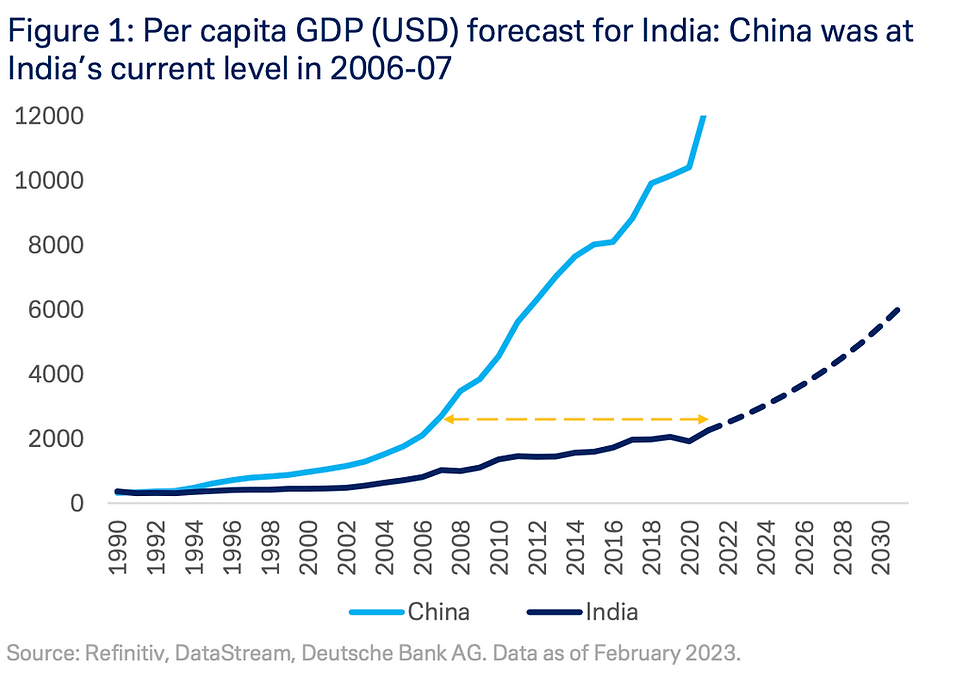India's Economic Boom: On Track to Become a $7 Trillion Economy by 2030!
- Abhedya Khatiwala
- Apr 29, 2023
- 5 min read

India's GDP is projected to double over the next seven years due to several inherent demographic advantages and policy-led changes. A young population with a large middle class is amplified by a slew of structural reforms, providing a demographic dividend. The country is also benefiting from investments in physical and digital infrastructure, a transition to clean energy, and rapid financialization, which are paving the way for high and sustainable growth. India's recent leapfrogging to a high level of digitization is already boosting productivity and efficiency in many ways. In this report, we examine a plethora of other factors that are contributing to India's growth momentum throughout the current decade.
India's Per Capita GDP (USD) Forecast: China was at India’s current level in 2006-07

The Indian economy appears poised for a remarkable expansion, with projections indicating a doubling of its current annual GDP, which stands at nearly USD 3.5 trillion, to USD 7 trillion by 2030. Sustaining such growth over a medium-term time frame will require more than just leveraging demographics or consumption, often cited as India's twin strengths.
The Youthful Advantage: How India's Demographic Landscape is Driving Economic Growth

India, the world's most populous country, is projected to add 97 million people to its working population over the next 10 years, surpassing China's working-age population in 2007. With a young median age of 28.4 years, rising to just 31.7 by 2030, India's demographic advantages of a youthful population are primed for utilization. India's workforce growth is set to be the largest of any country in the next decade, accounting for 22% of global workforce growth. Moreover, with the largest middle class in the world estimated at 371 million, India's affluence continues to rise, boding well for future consumption. Furthermore, a number of reforms, such as providing electricity, cooking gas, and clean water, have enabled women in rural areas to participate in economic activities, leading to the development of commercial enterprises such as handicrafts and poultry farming, thus increasing economic well-being in households.
Revolutionizing India's Future: The Impact of Policy-Led Reforms

India faces a challenge in creating jobs for its large population. To address this, the government has implemented a series of reforms that aim to increase productivity, reduce subsidy leakage, provide welfare, and create opportunities for economic enterprise. One such reform is the creation of the unique national ID card (Aadhaar), which has been linked to financially inclusive low-cost bank accounts (Jan Dhan) and mobile phone numbers, forming the JAM Trinity. This system has helped plug subsidy leakage and has facilitated the Direct Benefit Transfer to millions of people. Additionally, a massive push to create a road network is ongoing, with 73,000 kilometers of roads built over the past 10 years, and a daily construction rate of 36 kilometers. India is now fully electrified and aims to provide clean water to every household through the Jal Jeevan Mission, with 56% coverage already achieved and a target of full coverage by 2024. The Production Linked Incentive scheme for the manufacturing industry has also been introduced, incentivizing new investments across 14 sectors and aiming to create 6 million jobs. Electronic manufacturing has already seen significant benefits, with many global corporations setting up shops in India.
India's Bold Energy Transition Plan

India is transitioning towards cleaner energy sources as the old ways of carbon-intensive industrialization are no longer sustainable. This shift to renewable energy will enable sustainable economic development, improve energy security, and mitigate climate change. In recent years, India has made significant progress in providing access to electricity and clean cooking methods, achieving nearly 100% household access to electricity in 2019, while reducing the share of biomass in the energy mix by more than half. India has achieved its 2030 renewable energy targets from COP21, nine years ahead of schedule, with approximately 40% of installed capacity fueled by renewable sources. India is aiming to add over 340 GW of renewable capacity by 2030, taking renewable capacity contributions above 60%, with the majority of new addition expected to come from solar and wind. With green hydrogen, industrial usage can gradually switch away from coal, and transportation fuel can be replaced with EVs. It is optimistic that most of these targets will be met over the next few years.
India's Digital Transformation

India's information technology sector has helped digitize most of its services, including payments and e-commerce marketplaces. The government's "super app," UMANG, provides citizens with access to 1,682 services across federal and state levels. The Ayushman Bharat Digital Mission aims to integrate digital health infrastructure, including personal health records, while the Aarogya Setu app enabled the world's largest vaccination drive, with over 2.2 billion vaccinations enabled and validated through the app. The UPI is the most successful digital payments stack worldwide, with the highest payment transaction volumes globally. The latest initiative, ONDC, aims to revolutionize e-commerce by offering a network-centric model for connecting buyers and sellers, irrespective of their platforms. These initiatives have boosted productivity, reduced transaction costs, and leapfrogged India into the digital era in an unparalleled way.
Financialization

Millions of people have been integrated into the Indian banking system through the JAM trinity, with over 481 million beneficiaries holding INR1.89tn (over USD23bn) in bank accounts. This previously unbanked cluster now provides valuable data for fintech to enable lending to daily wage and self-employed people. The Goods and Services Tax (GST) now contributes almost USD20bn monthly to the government's coffers. Higher compliance through digital payments and low-interest rates has led to increased equity allocation, with the number of demat accounts exceeding 108 million and retail investors becoming the largest public participant in the markets at an annualized run rate of USD20bn. However, these growing numbers still account for only 4.8% of all household assets, leaving room for equity allocation to increase as per capita GDP approaches the USD4,000 inflection point.
Conclusion

India's growth story is set to take off, buoyed by a growing middle class and a young working-age population. With several structural tailwinds consolidating in recent years, India has the potential to become a USD economy by 2030. These include policy reforms aimed at creating a favorable environment for investment and entrepreneurship, a shift to clean energy, and the rapid inclusion of the massive informal sector into the formal economy. Furthermore, nearly 100% of the country's population has been given a digital identity, powering a digital revolution and leading to tremendous efficiency gains. With all these factors at play, India is on track to become the fourth-largest economy in the world by the end of this decade.

Thank you for taking the time to read this blog! If you like it do share it with your friends and family!
This blog is an excerpt from the report India: why it will be a USD 7 trillion economy by 2030 by Deutsche Bank AG. Sources of data include Refenitiv, DataStream, MOFSL, NSDL, CDSL, ACI Worldwide, BloombergNEF, Central Electricity Authority, UN, Morgan Stanley, and Govt. of India



Comments